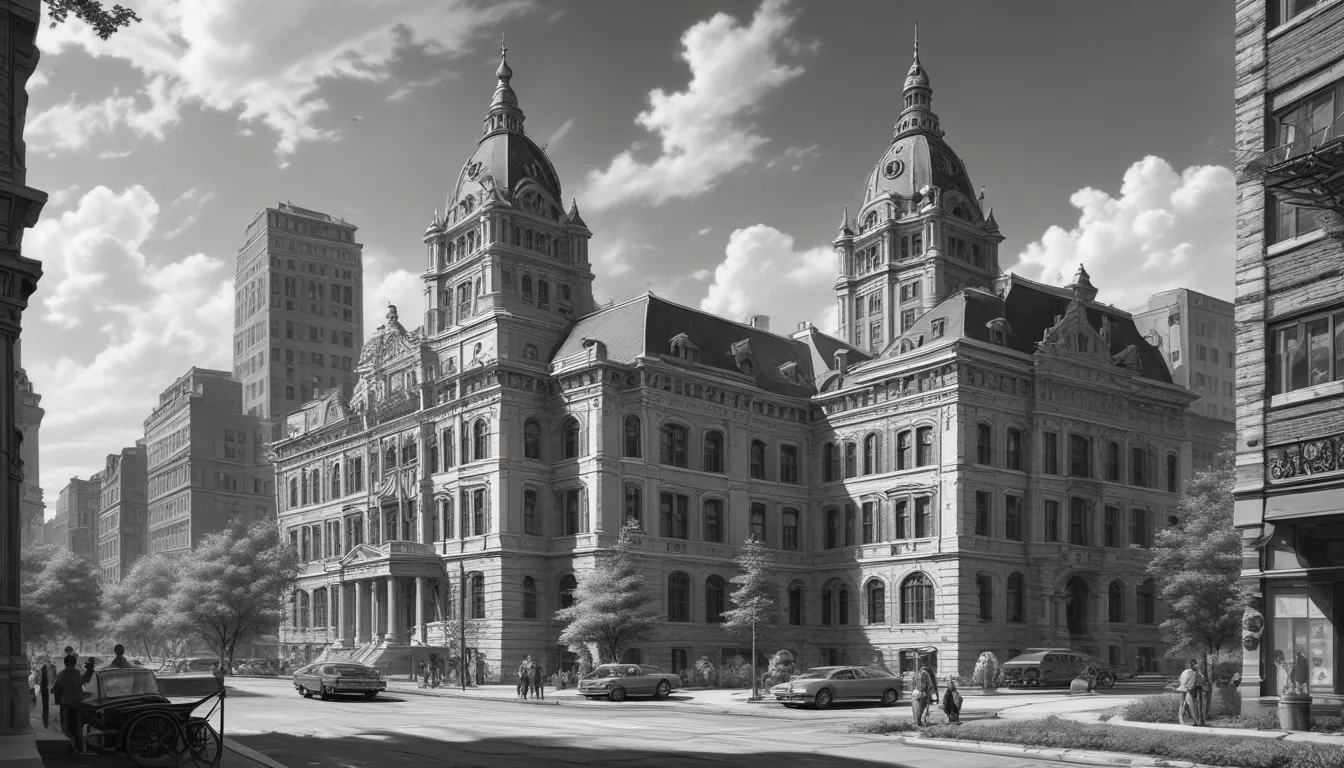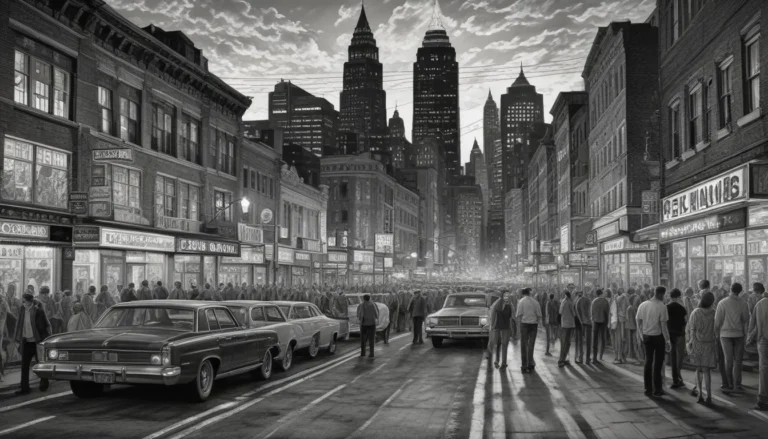The images in our articles are for illustrative purposes only and may not exactly match the content. They are intended to capture your interest and complement the text, not to replace it.
Welcome to St. Paul, Minnesota, a city brimming with rich history, vibrant culture, and stunning architectural landmarks. From the majestic Cathedral of Saint Paul to the historic Landmark Center, every building in this city tells a unique story of its evolution from a humble settlement to a bustling metropolis. In this article, we invite you to explore 14 fascinating facts about the architectural treasures that define St. Paul’s skyline. Get ready for an enlightening journey through the architectural tapestry of St. Paul, Minnesota.
Unveiling the Architectural Masterpieces of St. Paul
St. Paul, Minnesota, is home to a diverse array of architectural landmarks, ranging from opulent mansions to historic theaters, offering visitors a captivating journey through the city’s rich history and cultural heritage. Let’s explore some key takeaways about these architectural gems:
- The city’s architectural treasures, such as the Cathedral of Saint Paul and the Wabasha Street Caves, offer a glimpse into St. Paul’s past, showcasing its vibrant cultural landscape and captivating architectural allure.
The Magnificent Cathedral of Saint Paul
The Cathedral of Saint Paul, designed by architect Emmanuel Louis Masqueray, stands as a stunning architectural masterpiece in the heart of the city. With its towering dome reaching a height of 306 feet, this cathedral is one of the largest domes in the world. Visitors and locals alike are drawn to its striking exterior and intricate interior details, making it a must-see attraction in St. Paul.
Landmark Center: A Historic Cultural Hub
Originally serving as the Federal Court House and Post Office, the Landmark Center now functions as a vibrant cultural center in St. Paul. Its Richardsonian Romanesque-style design and listing on the National Register of Historic Places make it a focal point for art exhibitions, musical performances, and cultural festivals, enriching the city’s artistic and historical landscape.
James J. Hill House: An Opulent Gilded Age Mansion
Built for railroad magnate James J. Hill in 1891, the James J. Hill House is a prime example of Gilded Age architecture. This lavish mansion boasts 36,000 square feet of living space, 13 bathrooms, 22 fireplaces, and an exquisite art gallery, offering visitors a glimpse into the opulent lifestyle of the era.
Explore the Mysterious Wabasha Street Caves
Beneath the busy streets of St. Paul lie the enigmatic Wabasha Street Caves, with a history that includes serving as a speakeasy, nightclub, and even a mushroom farm. These sandstone caves are steeped in tales of gangster escapades, Prohibition-era revelry, and clandestine activities, providing visitors with a fascinating journey into the city’s past.
Minnesota State Capitol: A Majestic Symbol of Democracy
Designed by renowned architect Cass Gilbert, the Minnesota State Capitol stands as a breathtaking architectural marvel symbolizing grandeur and civic pride. Its magnificent dome, adorned with a golden quadriga sculpture, showcases the state’s commitment to democracy. Visitors can explore the Capitol’s rich history, admire its stunning murals and sculptures, and enjoy panoramic views of St. Paul from the observation deck.
Ramsey House: A Meticulously Preserved Victorian Mansion
Step back in time at the Alexander Ramsey House, a meticulously restored Victorian-era mansion that offers insight into the opulent lifestyle of Minnesota’s early political leaders. Guided tours allow visitors to immerse themselves in the elegant furnishings and décor of the Ramsey family, gaining a deeper understanding of the Victorian era and the state’s history.
Fitzgerald Theater: A Historic Performing Arts Venue
As the oldest active theater in St. Paul, the Fitzgerald Theater has been a cherished cultural institution for over a century. Its ornate architecture and rich history have attracted audiences to enjoy a diverse range of performances, from vaudeville acts to contemporary concerts, making it a beloved landmark in the city.
St. Paul Union Depot: A Grand Transportation Hub
Originally built in the Beaux-Arts style, the St. Paul Union Depot stands as a testament to the city’s historic role as a transportation center. After extensive restoration, the depot now serves as a modern transit hub, connecting passengers to trains, buses, and light rail. Its grand façade, vaulted ceilings, and expansive waiting room reflect its storied past and ongoing significance in the city’s transportation network.
Minnesota History Center: A Captivating Museum and Research Facility
Situated on Kellogg Boulevard, the Minnesota History Center offers engaging exhibits, educational programs, and archival resources that delve into the state’s rich history. Its modern architectural design and interactive displays provide visitors with an immersive journey through Minnesota’s past, spotlighting indigenous roots and contemporary developments.
Schmidt Brewery: A Historic Brewing Complex with Charm
Located in St. Paul’s West Seventh neighborhood, the Schmidt Brewery complex showcases the city’s brewing legacy and architectural heritage. The site, with its iconic clock tower and red-brick buildings, has been revitalized to accommodate residential, commercial, and cultural spaces. This revitalization honors the city’s industrial past while embracing new opportunities for community development.
F. Scott Fitzgerald House: Celebrating a Literary Legacy
The childhood home of renowned author F. Scott Fitzgerald, this modest yet charming house in St. Paul’s Summit Hill neighborhood preserves the early years of the literary icon. Now a museum dedicated to Fitzgerald’s life and works, visitors can explore his formative years and the inspirations behind his enduring literary contributions, providing insight into American literature and cultural history.
Como Park Conservatory: A Botanical Oasis in St. Paul
Situated within Como Park, the Marjorie McNeely Conservatory enchants visitors with its lush gardens, diverse plant collections, and stunning floral displays. The conservatory’s historic glass domes and immaculately landscaped grounds offer a peaceful retreat for guests to immerse themselves in nature’s beauty throughout the seasons, providing a horticultural experience for visitors of all ages.
Science Museum of Minnesota: A Dynamic Center of Scientific Exploration
With its striking modern architecture overlooking the Mississippi River, the Science Museum of Minnesota invites visitors to embark on a journey of discovery and innovation. Interactive exhibits, immersive theaters, and educational programs cater to curious minds of all ages, fostering a deeper understanding of science, technology, and natural history within the city.
Rice Park Historic District: A Charming Urban Oasis with Architectural Allure
Nestled in downtown St. Paul, the Rice Park Historic District captivates visitors with its elegant Victorian-era buildings, peaceful parkland, and vibrant cultural offerings. The district’s architectural diversity, ranging from Romanesque Revival to Beaux-Arts styles, reflects the city’s rich heritage and urban evolution. The picturesque park, adorned with sculptures and lush greenery, serves as a welcoming gathering place for residents and visitors, blending history, art, and natural beauty within the city.
In Conclusion
St. Paul, Minnesota, boasts a wealth of architectural landmarks that epitomize its history, culture, and innovation. From the iconic Cathedral of Saint Paul to the modern marvels like the Xcel Energy Center, these landmarks embody the city’s enduring spirit and artistic prowess. Exploring these architectural treasures offers a window into St. Paul’s past and present, highlighting the harmony between tradition and progress. With its diverse array of architectural wonders, St. Paul continues to enchant and inspire all who revel in its remarkable landmarks.
FAQs: Unveiling More Insights about St. Paul’s Architectural Heritage
What is the most iconic architectural landmark in St. Paul, Minnesota?
The Cathedral of Saint Paul is widely acclaimed as one of the city’s most iconic architectural landmarks, renowned for its breathtaking design and historical significance.
Are there guided tours available for exploring architectural landmarks in St. Paul?
Certainly! Various guided tours are accessible, providing visitors with an opportunity to delve into the rich architectural history of St. Paul and uncover the captivating stories behind these architectural marvels.
Can visitors access the interiors of the architectural landmarks for exploration?
Many of St. Paul’s architectural landmarks offer guided interior tours, allowing visitors to appreciate the intricate details and historical significance embodied within these structures.
How can I learn more about the architectural landmarks in St. Paul?
Visitors can access extensive information about the architectural landmarks through visitor centers, online resources, and specialized tours, offering a deeper understanding of the architectural and historical significance held by these structures.
Are there any special events or festivals celebrating St. Paul’s architectural heritage?
St. Paul hosts various events and festivals celebrating its architectural heritage, bringing the community together to appreciate the city’s rich architectural legacy through engaging activities and cultural festivities.
Dive into Reliable and Engaging Content
Our commitment to providing trustworthy and captivating content is paramount in our mission. Each fact on our site is contributed by real users like you, offering a diverse wealth of insights and information. Our dedicated editors meticulously review every submission to ensure the highest standards of accuracy and reliability. Trust in our dedication to quality and authenticity as you explore and discover alongside us.
Explore the vibrant architectural landscape of St. Paul, Minnesota, and embark on a journey through history, culture, and innovation. Let the city’s architectural landmarks mesmerize and inspire you as you delve into the rich tapestry of St. Paul’s architectural heritage.






